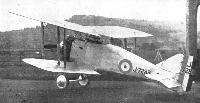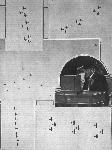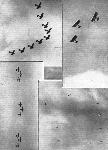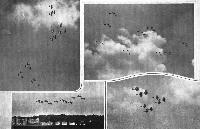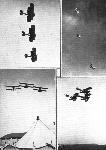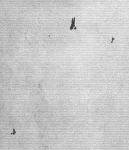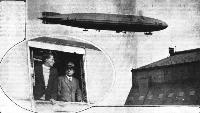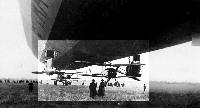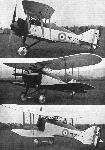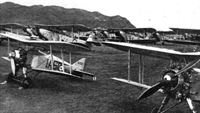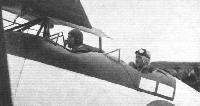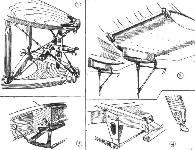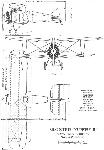
Gloster Grebe
Одноместный истребитель Grebe наряду с Hawker Woodcock и Armstrong Whitworth Siskin являлся истребителем, который рассматривался для обновления в межвоенный период парка британских ВВС. Самолет был спроектирован на базе опытного биплана Grouse. Потенциал данной машины был настолько высок, что Министерство авиации провело его оценочные испытания. По весьма обнадеживающим результатам этих испытаний были заказаны три прототипа. Первым стал прототип Grebe, который получил обозначение Grebe Mk I. Машина оснащалась одним двигателем Armstrong Siddeley Jaguar III мощностью 325 л.с. После оценочных испытаний данного прототипа тут же был выдан заказ на запуск в серию самолета на базе второго прототипа Grebe Mk II, в конструкцию которого внедрили ряд усовершенствований, включая шасси с управляемым хвостовым костылем и более мощный двигатель Jaguar IV.
Королевские ВВС Великобритании получили около 120 экземпляров Grebe Mk II, среди которых были двухместные тренировочные самолеты с двойным управлением Grebe (Dual). Первый самолет был передан в строевую часть в октябре 1923 года. Самолет оставался на вооружении строевых частей британских ВВС почти пять лет, за это время некоторые машины приняли участие в программах испытательных полетов. Например, Grebe Mk II стал первым истребителем британских ВВС, достигшим максимальной скорости в 386 км/ч, а еще два самолета данного типа со специальными приспособлениями на верхнем крыле привлекались к экспериментальным запускам в воздухе с британского дирижабля R33. В 1928 году три самолета Grebe были приобретены Новой Зеландией и поставлены в национальные ВВС.
ТАКТИКО-ТЕХНИЧЕСКИЕ ХАРАКТЕРИСТИКИ
Gloster Grebe Mk II
Тип: одноместный истребитель
Силовая установка: один звездообразный ПД Armstrong Siddeley Jaguar IV мощностью 400 л. с. (298 кВт)
Летные характеристики: максимальная скорость на уровне моря 243 км/ч; набор высоты 6095 м - за 23 мин; практический потолок 7010 м; продолжительность полета 2 ч 45 мин
Масса: пустого 780 кг; максимальная взлетная 1189 кг
Размеры: размах крыла 8,94 м; длина 6,17 м; высота 2,82 м; площадь крыльев 23,60 мг
Вооружение: два 7,7-мм пулемета Vickers вверху носовой части фюзеляжа
Описание:
- Gloster Grebe
- Flight, July 1923
Gothenburg International Aero Exhibition 1923
Фотографии
-
Мировая Авиация 141
Регистрационный номер: J7363 [3] Gloster Grebe был спроектирован Генри Фолландом на основе опытного самолета Grouse, также в новой машине заметно влияние и спроектированного им же SE.5. На рисунке - Grebe Mk II из британской 25-й эскадрильи.
-
Flight 1923-11 / Flight
Регистрационный номер: J6969 [7] The Gloucestershire "Grebe," a single-seater fighter scout, fitted with a 350 h.p. Armstrong-Siddeley "Jaguar." This machine will be flying during the Exhibition.
-
Aeroplane Monthly 1990-12 / O.Thetford, A.Lumsden - On silver wings (3)
Регистрационный номер: J6969 [7] J6969, the prototype Grebe. It made its first flight in time to appear at the RAF’s Hendon Pageant in June 1923. The upperwing fuel tanks are very prominent in this view.
-
Aeroplane Monthly 1990-12 / O.Thetford, A.Lumsden - On silver wings (3)
Регистрационный номер: J6969 [7] Grebe prototype J6969 at the RAF Pageant at Hendon on Saturday, June 30,1923. It was No 14 in the parade of new types, sharing the limelight with the Siskin and Flycatcher, amongst others. The Avro 504s in the background were taking part in a special Challenge Cup race.
Другие самолёты на фотографии: Avro Avro 504 - Великобритания - 1913
-
Flight 1923-07 / Flight
Регистрационный номер: J6969 [7] Gloucestershire "Grebe" (350 h.p. "Jaguar").
-
Aeroplane Monthly 1990-12 / O.Thetford, A.Lumsden - On silver wings (3)
Регистрационный номер: J6969 [7] Another view of Grebe prototype J6969 at the RAF Hendon Pageant in 1923. Powered by a 14-cylinder Armstrong Siddeley Jaguar III radial, the Grebe I had a maximum speed of 162 m.p.h. at sea level.
-
Flight 1923-07 / Flight
Регистрационный номер: J6969 [7] A NEW MACHINE AT THE R.A.F. PAGEANT: The Gloucester "Grebe," a single-seater fighter, fitted with a 350 h.p. Siddeley "Jaguar" engine.
-
Aeroplane Monthly 1990-12 / O.Thetford, A.Lumsden - On silver wings (3)
Регистрационный номер: J6969 [7] J6969 minus its “New Types" number. Note the non-standard style of the serial, particularly the ornate J on the rudder. This view also shows the armament - twin Vickers 0 303in machine-guns mounted forward of the cockpit.
-
Aeroplane Monthly 1989-06 / K.Wixey - Folland's racers (1)
Регистрационный номер: G-EBHA [5] G-EBHA, the demonstrator Grebe, was powered by a 385 h.p. Jaguar IIIA radial engine and is seen making its public debut at the 1923 RAF Air Pageant at Hendon. In 1926 it was rebuilt and re-engined with a 425 h.p. Jupiter IV.
-
Flight 1923-07 / Flight
Регистрационный номер: G-EBHA [5] THE KING'S CUP: The last three away. From right to left, Mr. George Robey's D.H.9 (450 Napier "Lion"), flown by Mr. A. J. Cobham, who came in second; Mr. J. D. Siddeley's Siddeley "Siskin" (325 Siddeley "Jaguar"), piloted by Mr. Frank T. Courtney, in whom was found the winner; Sir William Joynson-Hicks' Gloucestershire "Grebe" (325 Siddeley "Jaguar"), flown by Mr. L. L. Carter. This entry was the scratch machine.
Другие самолёты на фотографии: Armstrong Whitworth Siskin - Великобритания - 1921De Havilland D.H.9 - Великобритания - 1917
-
Flight 1928-10 / Flight
Регистрационный номер: G-EBHA [5] THE GLOSTER HELE-SHAW BEACHAM VARIABLE PITCH PROPELLER: On the left, a "close-up" view of the hub, blade roots, &c, on a Bristol "Jupiter VI." On the right, the propeller in flight on the same engine, in a Gloster "Grebe," piloted by Flying Officer H. J. Saint.
-
Aeroplane Monthly 1991-01 / O.Thetford, A.Lumsden - On silver wings (4)
Регистрационный номер: G-EBHA [5] The sole civil-registered Gloster Grebe flew as a demonstrator during 1923. It was rebuilt in 1926 and fitted with a 425 h.p. Bristol Jupiter IV engine and Gloster Hele-Shaw Beacham experimental variable-pitch propeller. Note the Gamecock-type undercarriage.
-
Flight 1923-07 / Flight
Регистрационный номер: G-EBHA [5] THE TWO SIDDELEY "JAGUAR"-ENGINED MACHINES READY TO GET AWAY: Left, the Gloucestershire "Grebe," the scratch machine, and, right, Mr. J.D.Siddeley's "Siskin," which was piloted to victory by Mr. Frank T. Courtney.
Другие самолёты на фотографии: Armstrong Whitworth Siskin - Великобритания - 1921
-
Flight 1925-11 / Flight
The Gloster "Grebe" II (Armstrong Siddeley "Jaguar") For a long period one of the most popular single-seater fighters in the Royal Air Force, the Gloster "Grebe," is now being gradually superseded by a later type, the Gloster "Gamecock," but it is still being used in large numbers. It has a fairly thick section, high-lift top plane and a thin-section, high-speed lower plane. It is claimed that at top speed the upper wing carries nearly the whole load, so that monoplane efficiency is approached. The "Grebe" is used by the following squadrons: No. 19 (Fighter), Duxford; No. 25 (Fighter), Hawkinge; No. 29 (Fighter), Duxford; No. 32 (Fighter), Kenley; and No. 56 (Fighter), Biggin Hill.
-
Flight 1925-11 / Flight
THE GLOSTER "GREBE II," ARMSTRONG-SIDDELEY "JAGUAR" ENGINE: Front view.
-
Aeroplane Monthly 1991-01 / O.Thetford, A.Lumsden - On silver wings (4)
The standard engine for the Grebe was the Armstrong Siddeley Jaguar IV of 400 h.p.
-
Aeroplane Monthly 1990-12 / O.Thetford, A.Lumsden - On silver wings (3)
Регистрационный номер: J7283 [4] J7823, the first production Grebe II, powered by a Jaguar IV engine of 400 h.p. First flown in August 1923, J7283 spent most of its career at the Aeroplane and Armament Experimental Establishment on flight test duties. It also spent some time with Nos 25 and 56 Sqns on Service trials in September 1924.
-
Air International 1980-07 / Fighter A to Z
Регистрационный номер: J7283 [4] The first production Grebe II, this type entering RAF service in October 1923 and remaining first-line equipment until mid-1928.
-
Flight 1925-11 / Flight
Регистрационный номер: J7283 [4] THE GLOSTER "GREBE II": Three-quarter rear view.
-
Aeroplane Monthly 1990-12 / O.Thetford, A.Lumsden - On silver wings (3)
Регистрационный номер: J7283 [4] -
Aeroplane Monthly 1988-05 / Personal album. Military
Регистрационный номер: J7287 Gloster Grebe II J7287 was one of the first production batch of 12. It went to 25 Sqn, the first unit to be fully equipped with the type, in October 1924 (Grebes were used by just one flight of 111 Sqn at Duxford from October the previous year).
-
Aeroplane Monthly 1991-01 / O.Thetford, A.Lumsden - On silver wings (4)
Регистрационный номер: J7363 [3] A splendid line-up of 25 Sqn Grebe Mk IIs at Gloster's Hucclecote aerodrome. J7363 spent most of its Service career with this squadron except for a brief period at the Home Aircraft Depot in February 1927.
-
Aeroplane Monthly 1991-01 / O.Thetford, A.Lumsden - On silver wings (4)
Регистрационный номер: J7363 [3], J7402 Another view of eight 25 Sqn Grebes taken at Gloster's Hucclecote aerodrome, shortly after manufacture.
-
Air Pictorial 1988-01 / J.Rawlings - No.29 Squadron - First with Tornado F.3
Регистрационный номер: J7381 [3], NZ501 [3] No. 29 Squadron Gloster Grebe J7381 marked with four red Xs in the hangar at Ouxford
-
Aeroplane Monthly 1991-01 / O.Thetford, A.Lumsden - On silver wings (4)
Регистрационный номер: J7413 Grebe II J7413 in 56 Sqn markings. This squadron received its first Grebes, at RAF Biggin Hill, in September 1924. They were replaced with Siskin IIIAs exactly 3yr later.
-
Aeroplane Monthly 1991-01 / O.Thetford, A.Lumsden - On silver wings (4)
Регистрационный номер: J7576 25 Sqn Grebes taking part in RAF/Army manoeuvres in September 1925. J7576 later passed to 29 Sqn for a short period in 1927.
-
Air Enthusiast 1971-09 / R.Braybrook - Biplane Era: The Flight from Reality /Fighters in the RAF/ (1)
Регистрационный номер: J7583 The first significant fighter to enter service after the end of the war was the Gloster Grebe, shown here in the markings of No 56 Squadron. The Grebe was the first of a series of Gloster fighters which were in service with the RAF almost without interruption from 1923 to 1967.
-
Aeroplane Monthly 1991-01 / O.Thetford, A.Lumsden - On silver wings (4)
Регистрационный номер: J7588 Grebe J7588 in the markings of 32 Sqn, based at RAF Kenley. This Mk II aircraft later passed to 25 Sqn.
-
Aeroplane Monthly 1991-01 / O.Thetford, A.Lumsden - On silver wings (4)
This Grebe is pictured at RAF Northolt on the occasion of a race for fighter squadron aircraft held on May 26, 1927. This 25 Sqn machine was flown by Fg Off L. E. Maynard.
-
Flight 1925-10 / Flight
"THE CUCKOOS" (No. 25 FIGHTER SQUADRON): "Off in Eight Minutes." Pilots running to their Grebes on receipt of urgent order.
-
Flight 1927-06 / Flight
THE SIR PHILIP SASSOON CUP RACE AT NORTHOLT: Three Gloster "Grebes" are here shown starting for the race.
-
Flight 1928-06 / Flight
GLOSTER "GREBE": Single-seater Fighter, with Armstrong-Siddeley "Jaguar" Engine.
No 25 Squadron took delivery' of Grebe IIs in October 1924. Bonar was an NCO pilot with this squadron and he was a member of the nine-aircraft team that performed synchronized aerobatics at the 1925 RAF Pageant at Hendon, led by Sqn Ldr A. H. Peck. -
Aeroplane Monthly 1990-12 / O.Thetford, A.Lumsden - On silver wings (3)
A very excellent show: Two Gloster "Grebes" came over from Hawkinge during the meeting and gave a wonderful demonstration of evolutions in "formation." They are here seen about to return to their nest.
Gloster Grebes of 25 Sqn taking off in formation. Note that the squadron markings, two parallel black bars, extend forward onto the exhaust collector rings. -
Aeroplane Monthly 1977-09 / Personal album
A Gloster Grebe single-seat fighter "coming home to roost" at dusk. The Grebe served as a front-line fighter with the RAF during 1923-1929, and 129 were produced for the Service. This example has the vee strut bracing to the top wing extensions, added to counter wing flutter.
-
Flight 1925-10 / Flight
TAKING OFF BY FLIGHTS: In eight minutes exactly from receipt of the order the three flights of No. 25 Squadron were in the air
-
Flight 1926-07 / Flight
AT THE R.A.F. DISPLAY: The first event of the afternoon was the Group Evolutions of six Fighter Squadrons (54 machines), one squadron of which (No. 32) is shown about to land.
-
Flight 1926-06 / Flight
PRACTISING FOR THE PAGEANT: A formation of Gloster "Grebes" with Armstrong-Siddeley Jaguar engine, setting out for a low-bombing contest at Duxford aerodrome.
-
Aeroplane Monthly 1991-01 / O.Thetford, A.Lumsden - On silver wings (4)
A formation of 56 Sqn Gloster Grebes taking off from RAF Duxford to begin a bombing-contest rehearsal for the forthcoming RAF Pageant at Hendon, in May 1926.
-
Flight 1925-10 / Flight
No. 56 Fighter Squadron off on a mission
-
Flight 1925-10 / Flight
THE RETURN AND THE DISPERSE: No. 25 has accomplished its mission
-
Flight 1925-07 / Flight
"HALLO, MOSQUITOS! ALTER COURSE 16 POINTS OUTWARDS." - This was the command given by the King to No.25 Fighter Squadron, under Squadron-Leader A. H. Peck, by means of wireless during the squadron drill at the R.A.F. Display. We show above his Majesty speaking into the microphone, and also some of the formations carried out by the nine "Grebes." (1) "Flight Mass Line Abreast." (2) "Flight Mass Echelon to Port." (3) "Double Line Ahead" (immediately preceding the King's order). (4) "Line Abreast." (5) "Flight Mass Line Ahead."
-
Flight 1926-07 / Flight
AT THE R.A .F. DISPLAY: Four movements in the air drill by wireless carried out by No. 25 Squadron. Left (top) "Squadron"; (bottom) "Flight Mass Line Abreast." Right (top) executing a half-roll; (bottom) right about turn (via a loop).
-
Flight 1926-07 / Flight
AT THE R.A.F. DISPLAY: Event No. 1 (afternoon) Group Evolutions by Six Fighter Squadrons (54 machines). Some of the evolutions. On the right (top) will be seen one Wing of three squadrons (Nos. 19, 29, and 41) in "Mass line ahead." Our camera was not large enough to get in all 54 machines.
-
Flight 1926-09 / Flight
FORMATION FLYING EXTRAORDINARY: Daily visitors to Lympne during the light 'plane competition were "Grebes," "Woodcocks" and "Gamecocks," whose evolutions were generally admired. Our photographs show these machines in various formations.
Другие самолёты на фотографии: Hawker Woodcock - Великобритания - 1923
-
Flight 1927-10 / Flight
THE RETURN OF THE SCHNEIDER TEAM: The Armstrong-Whitworth "Argosy" of Imperial Airways, Ltd., arrives at Croydon aerodrome, escorted by six Gloster "Grebes" and a de Havilland 50. Considering the extremely gusty wind, the "Grebes" kept excellent formation.
Другие самолёты на фотографии: Armstrong Whitworth Argosy - Великобритания - 1926De Havilland D.H.50 - Великобритания - 1923
-
Flight 1925-10 / Flight
THE RETURN AND THE DISPERSE: Letting off Steam. After breaking formation the pilots of No. 25 display a little individuality.
-
Flight 1925-07 / Flight
FIGHTING TACTICS AT THE R.A.F. DISPLAY: Event No. 6, an aerial combat between a Boulton and Paul "Bugle" twin-engined bomber, piloted by Sqdn.-Ldr. W. H. Longton, D.F.C., A.F.C., and two Gloucestershire "Grebe" single-seater fighters, piloted respectively by Flight-Lieut. H. A. Hammersley, M.C., and Flying Officer J. N. Boothman. In this display the bomber (in centre) put up an excellent defence.
Другие самолёты на фотографии: Boulton Paul P.15 Bolton / P.25 Bugle - Великобритания - 1922
-
Flight 1925-07 / Flight
FIGHTING TACTICS AT THE R.A.F. DISPLAY: In Event No.9 a demonstration of flight evolutions in aerial attack was given by three Siddeley ''Siskins'' (No. 41 Fighter Squadron), three Gloucestershire "Grebes" (No. 32 Fighter Squadron), and two Bristol Fighters (No.24 Communication Squadron), In the picture some of the "Siskins" and "Grebes" are seen opening the attack on one of the Bristol Fighters.
Другие самолёты на фотографии: Armstrong Whitworth Siskin - Великобритания - 1921Bristol F.2A/F.2B Fighter - Великобритания - 1916
-
Flight 1927-07 / Flight
EVENT 9, AN AIR ATTACK ON LONDON: An "enemy" squadron of day-bombers (D.H.9's) are followed by another squadron of "enemy" machines (Vickers "Virginias" night-bombers), which are being attacked by defending single-seater fighters (Gloster "Grebes"), and one is seen "in flames."
Другие самолёты на фотографии: Vickers Virginia - Великобритания - 1922
-
Flight 1929-07 / Flight
EVENT G. "SERVICE SKYWRITING": One of the two Gloster Grebes which took part in an "illuminating" display of Individual Aerobatics, assisted by the Savage Skywriting apparatus. It is seen, with its column of orange smoke, executing a half-roll.
-
Flight 1930-07 / Flight
Links in the Chain: Three Martlesham pilots giving an exhibition of aerobatics with smoke.
-
Flight 1931-07 / Flight
MORE SMOKED AEROBATICS: THE FORMATION OF A HUGE SPIRAL
-
Flight 1930-07 / Flight
Another evolution by the same pilots mounted on Grebes.
-
Flight 1931-07 / Flight
MORE SMOKED AEROBATICS: A TRIPLE LOOP
-
Aviation Historian 26 / M.Bearman - Our Man in California
Addams leads the A&AEE’s formation aerobatics team of three smoke-equipped Gloster Grebes, the other two being flown by fellow Flt Lts D.M. Fleming and C.B. Wincott, at Hendon in June 1931.
-
Flight 1931-07 / Flight
AEROBATICS IN SMOKE: THE THREE "GREBES" FORMING "PRINCE OF WALES' FEATHERS." THE EFFECT OBTAINED BY USING COLOURED SMOKE (ORANGE AND WHITE) IS VERY MARKED.
-
Flight 1931-07 / Flight
AEROBATICS IN SMOKE: THE THREE "GREBES" FORMING "PRINCE OF WALES' FEATHERS." SIX PICTURES SHOW, FROM TOP TO BOTTOM, PROGRESSIVE STAGES IN THE MANOEUVRE
-
Flight 1931-07 / Flight
MORE SMOKED AEROBATICS: THE SIX VIEWS AGAIN SHOW PROGRESSIVE STAGES: THIS TIME IN THE FORMATION OF A WREATH OF INTERWOVEN ORANGE AND WHITE TRAILS.
-
Flight 1926-07 / Flight
AT THE R.A.F. DISPLAY: The Low-Bombing Competition. One of the Gloster "Grebes" of No. 19 Squadron makes a direct hit on the moving tank.
-
Flight 1927-07 / Flight
THE BIRMINGHAM AIR PAGEANT: One of the "Grebes" from No. 25 Squadron "converging" on the tank in the bombing attack.
-
Flight 1925-04 / Flight
H.R.H. THE INFANTE DON ALFONSO OF SPAIN VISITS THE GLOUCESTERSHIRE AIRCRAFT COMPANY: The photo shows the Infante Don Alfonso inspecting the Siddeley "Jaguar" engine of a Gloucestershire "Grebe."
-
Aeroplane Monthly 1979-03 / J.Corlett - One good turn
A Gloster Grebe displaying the black bars of Hawkinge-based No 25 Squadron along its fuselage is ministered to by a Hucks starter.
-
Flight 1926-10 / Flight
H.M. AIR AIRCRAFT CARRIER, R.33: The British rigid airship, R.33, with two Gloster "Grebes" attached, just before ascending from Pulham on October 21.
-
Flight 1937-11 / Flight
The airship R.33 with her two Gloster Grebes, which were successfully flown-off and re-attached a number of times in 1926.
-
Flight 1926-10 / Flight
H.M. AIR AIRCRAFT CARRIER, R.33. The R.33 takes the air (with two Gloster "Grebes") once again after a year's rest. Inset, Major G. H. Scott, who was in command, and his second officer, Squad.-Leader R- Booth, in the control car.
-
Jane's All the World Aircraft 1980 / Encyclopedia of Aviation - Aircraft A-Z - v3
Gloster Grebe beneath airship R33.
-
Flight 1937-11 / Flight
Lighter-than-air starting: Two Gloster Grebes suspended under the keel of R33 preparatory to being dropped from the airship in flight.
-
Flight 1926-10 / Flight
21 октября 1926г.: два доработанных истребителя Gloster Grebe на высоте 760 м выполнили отцепку от жесткого дирижабля R 33.
"LIGHTER-HEAVIER-THAN-AIR": A close-up of the R.33 (or part of same) and the two Gloster "Grebes." Each of the latter weighed over a ton, and were successfully launched from about 2,000 ft. -
Flight 1926-10 / Flight
Регистрационный номер: J7400 [2] R.33 AS AIRCRAFT CARRIER: Two detail views showing the suspension of the Gloster "Grebes" from the airship's keel. Each machine was suspended by a central quick-release attachment to the top plane centre section, whilst three struts, two to the wings and one to the fuselage near the tail, served to prevent the machine oscillating. Note the flexible piping running from the keel to the side of the fuselage, which conveyed the mixture from the Bristol "Gas" starter (in airship) to the "Grebe's "Jaguar" engine.
-
Aeroplane Monthly 1991-01 / O.Thetford, A.Lumsden - On silver wings (4)
Регистрационный номер: J7400 [2] Two views of Grebe J7400 taken at Pulham, Norfolk, during airship launching trials with the R33 during the final months of 1926. J7400 and J7385 were used for a series of trial launchings from R33. Quick-release attachments were fitted to the upper wings and the engines were started by means of flexible piping connected to a gas starter inside the airship.
-
Flight 1926-10 / Flight
"DROPPING THE PILOT" - NEW STYLE: One of the two Gloster "Grebes" carried by R.33 gets well away during the tests at Pulham last Thursday. Piloted by F/O Mackenzie-Richards, the "Grebe" fell about 100 ft. before complete control was obtained, when, opening out his engine - note the "prrrup" of smoke - the pilot made a half-roll and then flew away.
-
Aeroplane Monthly 1990-12 / O.Thetford, A.Lumsden - On silver wings (3)
Регистрационный номер: NZ501 [3], J7381 [3] GLOSTER "GREBES" FOR NEW ZEALAND: This photograph shows the first of a batch of the latest type "Jaguar"-engined "Grebes" ordered by the New Zealand Government from the Gloster Aircraft Co.
J7381 was one of three Grebes sold to New Zealand. Renumbered NZ501, the ex-29 Sqn machine was first test-flown there on March 2, 1928, and remained in service for more than 10yr. -
Flight 1928-08 / Flight
Регистрационный номер: NZ503 GLOSTER "GREBES" FOR NEW ZEALAND: These three photographs show the two-seater Gloster "Grebe." Armstrong-Siddeley "Jaguar" engine, of which a batch has been ordered by the New Zealand Government.
This two-seat Grebe, NZ503, was delivered to the New Zealand Permanent Air Force and assembled in 1928. The aircraft remained in NZPAF service until written off during an aerobatic display at Hornsby on August 8, 1932. -
Flight 1928-08 / Flight
A HUSTLER: One of the Gloster "Grebes" built for the New Zealand Air Force is here seen in flight, piloted by Capt. H. Saint.
-
Flight 1938-08 / Flight
HARKING BACK IN NEW ZEALAND: Some old-timers still in service with the Royal New Zealand Air Force lined up for inspection by the Governor-General, Lord Galway, at Rongotai Aerodrome. The pretty little fighters in the foreground are Gloster Grebes (circa 1928) and behind are Blackburn Baffins.
Другие самолёты на фотографии: Blackburn Baffin / B-5 - Великобритания - 1933
-
Aeroplane Monthly 1990-12 / O.Thetford, A.Lumsden - On silver wings (3)
Регистрационный номер: J7519 In autumn 1924 Grebe J7519 was converted into the prototype two-seat trainer.
-
Aeroplane Monthly 1991-01 / O.Thetford, A.Lumsden - On silver wings (4)
Регистрационный номер: J7520 [2] Grebe J7520, with Flt Lt Richard Atcherley as pilot and Flt Lt G. H. Stainforth as navigator, taking off from Heston at the start of the two-day King’s Cup air race, held on July 5-6, 1929. This combination won the race with an average speed of 150 m.p.h. for the 1,160-mile course.
-
Flight 1935-09 / Flight
Регистрационный номер: J7520 [2] THE KING'S CUP WINNER: Flight-Lieut. R. L. Atcherley ("Llewellyn") on the Gloster "Grebe" (Armstrong-Siddeley "Jaguar") entered by Sir Walter Preston, starting from Heston, and (inset) "crossing the line." The second "Grebe," with its entrant, the Hon. F. E. Guest, as passenger, and piloted by F./O. E. H. Fielden, is seen in the background.
-
Flight 1928-07 / Flight
The King's Cup Air Race: Flying Officer Atcherley (left) and his passenger in the Gloster "Grebe" (Armstrong-Siddeley "Jaguar") which was the first machine in at Glasgow on Section I of the race.
-
Aeroplane Monthly 1990-12 / O.Thetford, A.Lumsden - On silver wings (3)
Регистрационный номер: J7381 [3], J7593, NZ501 [3] KEITH WOODCOCK’S painting depicts two Grebes of 29 Sqn.
-
Aeroplane Monthly 1982-07 / Painted Wings
Регистрационный номер: J7405, J7409 Kenneth McDonough's striking painting depicts three Gloster Grebes of No 56 Sqn passing low across the 1926 RAF Hendon Pageant set piece and is entitled "Hendon 1926"
-
Flight 1925-07 / Flight
"AFTER YOU WITH THAT TANK!" One of the most thrilling events seen at this year's R.A.F. Display at Hendon was the demonstration of Low Bombing by three Gloucestershire "Grebes" from No. 25 Fighter Squadron, and three Siddeley "Siskins" from No.41 Fighter Squadron. Instead of the machines diving on to their target - a stranded Tank - one after another from the same direction, they maintained a continuous attack, swooping down in rapid succession from all directions, with, apparently, only a matter of yards separating each machine, and releasing their bombs from about 50 ft. without the use of bombsights or such-like gadgets. The picture by Charles Dickson, gives one an excellent impression of this wonderful "criss-crossing" manoeuvre by the machines.
Другие самолёты на фотографии: Armstrong Whitworth Siskin - Великобритания - 1921
-
Flight 1925-11 / Flight
SOME "GLOSTER" CONSTRUCTIONAL DETAILS: 1 shows the tail-plane support and elevator crank as well as fittings for the stern-post, etc., of the "Grebe." In 2 are seen the gravity petrol tanks, mounted in the top plane, the petrol cocks being within reach of the pilot from his cockpit. The fuel flows to a distributor (shown last week) which enables fuel to be taken from either or both tanks. The ailerons of the Gloster "Grebe'' and "Grouse" are operated, as regards the lower flaps, by a crank of the form shown in 3, which is mounted on a specially strengthened rib, and from which tie rods run to the controls, while a steel tube runs to the aileron crank, as shown in 4. The movement is transmitted to the top ailerons by struts, the attachment for which is shown inset in 4.
-
Aeroplane Monthly 1990-12 / O.Thetford, A.Lumsden - On silver wings (3)
A rigging illustration from A.P.1168, the RAF’s manual on the Grebe, published in November 1927. The aircraft was of conventional wooden construction throughout.
-
Aeroplane Monthly 1991-01 / O.Thetford, A.Lumsden - On silver wings (4)
Gloster Grebe squadron colours.
Key to sketches: A Grebe J7386 of 19 Sqn, based at Duxford. B J7581 of 25 Sqn at Hawkinge. C J7593 of 29 Sqn at Duxford. D J7361 of 32 Sqn at Kenley. E J7415 of 56 Sqn at Biggin Hill. -
Air Pictorial 1961-12 / J.Rawlings - 25 Squadron History
Gloster Grebe II
-
Flight 1925-11 / Flight
Gloster "Grebe II" Armstrong-Siddeley "Jaguar" Engine
-
Air International 1980-07 / Fighter A to Z
The Grebe II was the first Gloster aeroplane produced in substantial numbers for RAF service.
- Фотографии


















